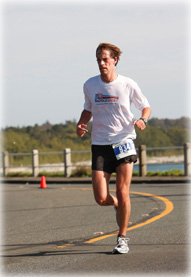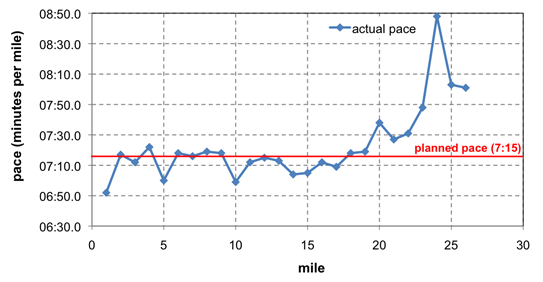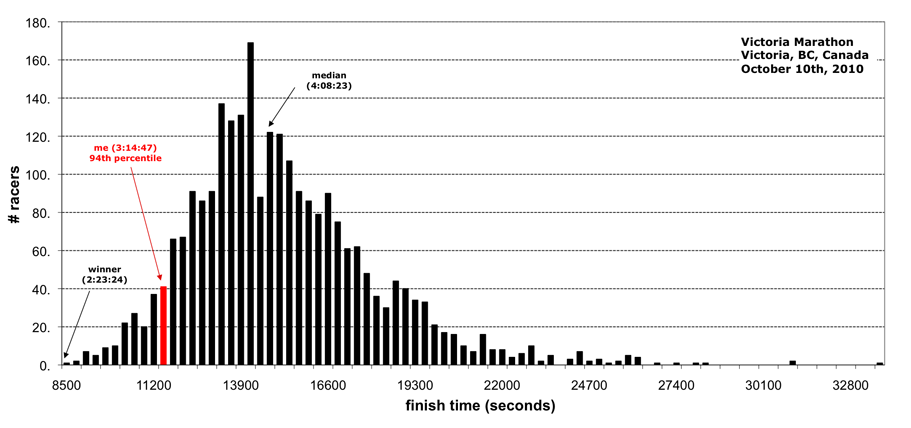[ overview | the course | my race day | race telemetry | thanks ]
Overview
I'm a triathlete and running has always been my achilles heel. This season, my coach Jake helped to make the unlikely happen: he guided me to successfully avoid injury and regain strong running form. After a few very successful half-irons and IM St. George, I decided to test my running chops by making a bid for Boston qualification at the Victoria marathon. My friend Anthony decided to make a go at it as well, so we did a lot of training and strategizing together.
Qualifying for the Boston marathon is a tough but reachable goal. It's a time-based threshold: for my age group (M35-39), the qualification cutoff time is 3:15:59, which is a 7:28.5 min/mile pace. A few months before Victoria, my tempo running pace was at 6:40 min/mile over 8 miles, and I'd done some 13 milers at about a 7:10 pace, so things looked good!
I ran into the typical issues over the months leading up to Victoria, including minor injury and training fatigue. And, I nearly blew the race by running too fast over the first 18 miles and hitting the wall hard at mile 23. After all the dust had settled, the training and planning had paid off: I made it, finishing Victoria with a little over a minute to spare under the BQ time!! Next stop, Boston.
The course
Victoria is on the southern tip of Vancouver Island off the west coast of Canada. In October, Victoria is cool (mid-50s Fahrenheit) and windy. Because the city is in the shadow of the Olympic mountain range, rain is unlikely during the race, but it does happen from time to time.
The marathon course starts next to the legislative buildings in the inner harbour of Victoria. It heads east through downtown Victoria, and then winds south, taking you through the hills of Beacon Hill Park. Next, the course turns back east along the shore of Ross Bay on Dallas Road; this is the first spot you'll have to assess the winds coming off the ocean. Chances are the wind will be at your back now, but that means you'll have a headwind on the hard last quarter of the race.
The course diverts inland over some mild hills through residential neighbourhoods, dumping you back on the coast of McNeill Bay and Beach road. Next, you head North through the Victoria Golf Club and follow the coast of Oak Bay. This stretch of road is very exposed, and you'll definitely feel the wind at your back here. After hitting the halfway mark, you'll keep going north for another three miles to the turnaround in Uplands.

The route back is mostly the same, except you stick to the shoreline instead of diverting through Beacon Hill Park. The last five miles are extremely rough. When you round a corner past Clover Point, the wind will gust in your face. Many people crack here, but if you gut through it, you'll be in the home stretch.
The last two miles curve back into the inner harbour, threading through the condo and apartment buildings to take back to the finish line between the Empress Hotel and the legislative buildings. Enjoy the last quarter mile; it's flat and lined with cheering spectators.
The course elevation profile is relatively mild, with about 500-600 feet of climbing in total. But, two hills late in the race seem designed to break you right as you hit the wall. Both are gradual and long, lasting about a mile, and both likely have a headwind. The first is at mile 19, the second at mile 23. If you can remember to do it, fuel up before you hit each and force yourself to open back up once you crest.
There are aid stations about every 3km along the course (1.6 miles), but most them only have gatorade and water. You'll only come across gels at 13km (8 miles) and 34km (21 miles), so plan ahead. My strategy was to carry two gels with me at the start and pick up two more at each aid station, so that I always had one in hand.
My race day
Pre-race. Sunny raced the half-marathon, which started at 7:30am. We woke up early, ate some breakfast at the hotel (cereal, toast, and OJ for me), and wandered off to the start line by 7:10am. After seeing Sunny off, I came back to our hotel, got prepped for the race, and came back for my 9:00am start.
I knew that making the Boston cutoff was going to be tough, so I decided to start near the front of the pack to minimize the chance of getting caught up on a throng of slower runners. This was a good call; as it turns out, I didn't have an extra minute to spare. The gun went off, I was across the start line ten seconds later, and we were off! People around me were roughly at my level, so there was absolutely no crowding or dodging around other runners.

The first mile was completely effortless. About halfway through it, I glanced at my GPS watch, and noticed I was running far too fast: 6:30 min/mile, instead of the 7:15 min/mile I'd planned. It was surprisingly hard to slow down, between having fast runners around me, the adrenaline of the race, and the honeymoon period where my HR hadn't yet climbed up to its steady state. But, I managed to do it, and mile 2 was at a normal 7:17 min/mile.
The first half of the race went beautifully well, though I did pace a few seconds per mile faster than planned. There was no pain, the effort was hard but manageable, and I got into a nice rhythm. My only technical problem was with my iPod; I was using a Belkin headphone cable extender because the Belkin has iPod volume and song navigation controls on it, but as I became more sweaty, the Belkin must have taken on moisture as it started to flake out. So, I ditched the extender and just jacked the earbuds directly into the iPod, which required a little futzing with the iPod to clip onto my heartstrap, as the earbud cables were a little short.
Mile 10 was a real joy; it was downhill with a tailwind, and I still felt fresh. My pace was a speedy 6:59 min/mile over that mile, and over the first half of the race, I averaged 7:12 min/mile, putting me in position for about a 3:09:00 or 3:10:00 finish, with six minutes to spare for the BQ threshold.
The turnaround was at mile 15. A minute or two after turning
around, I saw Anthony cruising at a solid pace; I figured he was
about a half mile behind me, and in perfect position to make his
3:20:59 cutoff with five minutes to spare. That was a great morale
boost...if things kept going according to plan, we'd both be at
Boston in 2011.

The real work of the race started at mile 17. My legs were starting to fatigue and my HR had climbed up to the mid-170s by that point. I started to worry about nutrition and hydration. I'd stuck to plan: taking on a small gulp of gatorade at every aid station and eating a powergel every 4 miles. But, I've always had trouble with the glycogen wall at around mile 18.
As the race course diverted back into residential neighborhoods, I found myself noticing the hills much more than before. My mind also started thinking bleaker thoughts, trying to figure out how much juice I had left in the tank, how much I could afford to slow down and still make the threshold, and whether or not I'd make it at all. Spectators cheering started being an annoyance rather than a boost. The legs started to feel heavy, and it was harder and harder to maintain my cadence. I could feel my shoulders hunching and my back bending. All of these were signs that I was about to glycogen deplete and hit the wall.
From miles 20 to 23, I slowed to about a 7:30 min/mile pace, which was totally fine, but mentally hard to accept. The bonk was happening, and now it was a question of whether I'd have the guts to grind through the last 3 miles in spite of my body rebelling. Something my coach said when talking through the race stuck in my head: Jake said that the first half of the marathon would be easy, the next quarter would be hard, and the final 6 miles would have to be a full-on mind-over-body experience. Sure enough, that's exactly what was happening.
Mile 24 was the pinnacle of pain. It was a slow uphill along the coast, with a steady headwind, and it felt neverending. The good news was that I could see an aid station at the crest of the hill, but looking at my watch, the hill was reducing me to about a nine minute per mile pace. At this point, I'd averaged 7:16 min/mile over 23 miles. I'd have to finish the last 3.2 miles with a pace faster than 8:57 min/mile to make Boston! This was going to be close. If completely cracked or walked even part of a mile, I'd lose Boston.
So, it was time to HTFU. I had one last gel; I ate it, gritted my teeth, and forced my legs to turn over a little faster. My hamstring started to cramp, which just added to the suffering. Every step was pain, and my body felt like it was swimming through molasses. My coach would later describe this feeling as running with a piano on your back, and that's exactly what it felt like. The miles would just not go by.

Mile 24 clocked in at 8:48; slow, but fast enough to make Boston, and better, it was the last big hill so there was hope going forward. I started doing some funny stride modifications to work around the hamstring cramp. I accelerated a bit over mile 25, and averaged 8:03. It nearly killed me. Mile 26 (last mile!!) went by in 8:01. Down to the last thousand feet. Around the corner, and it's the home straightaway. There's the finish line, and the race clock was at 3:14:30. I could not accelerate, but I wasn't going to slow down either; I crossed the line at gun time 3:14:56, and chip time 3:14:47. I'D DONE IT!
As soon as I stopped running, my right knee locked up. Whatever funny gait I had been doing over the past two miles to avoid the hamstring cramp had tickled my ITB attachment point, and I couldn't flex the knee anymore. No matter, I hit my goal and was going to Boston! Anthony crossed the line a little under a minute later; he finished with five minutes to spare, and we'll be heading to beantown together in April '11.
It was a great race. In retrospect, I should have taken it even easier over the first half marathon and negative split the second half. (This is what Anthony did!) But, as I told myself before starting, this was a one-bit outcome race: anything below 3:15:59 was success, anything above was failure. It didn't matter that I could have run a more perfect race; I ran the race i needed to run to hit a goal I wasn't sure I could make. Time to celebrate, heal, and then I can start thinking about the 2011 season.
Telemetry
Here's the telemetry from my Garmin 405 GPS watch. Click on it to be taken to a page with detailed splits, heart race, cadence, and other data.
Here's a graph of my mile-by-mile pace splits; the pace plan, of 7:15 min/mile steady throughout, is shown in red. You can see I ran a little fast for the first 18 miles and suffered badly over the last 6. I imagine the two are linked...

Anthony ran a nearly perfect race, finishing 45 seconds behind me. He started conservatively at about 7:40 min/mile, and accelerated down to 7:20 min/mile at the end. For kicks, Anthony plotted how far ahead of him I was as the race progressed. I added the red annotations to the graph; the truth hurts. I kind of feel like Chris Lieto getting run down by Craig Alexander in Kona 2009, but of course, much much slower. :)

And, last but not least, here's a histogram with my finishing position. (Anthony was in the same red bar as me.)

Thanks
I owe my success to the great planning and support of Jake Bartholomy (my coach from team PauoleSport), and to Anthony L. for keeping me honest and motivated during training.
